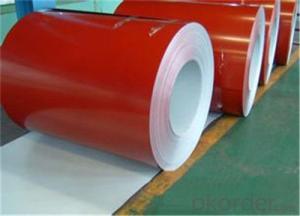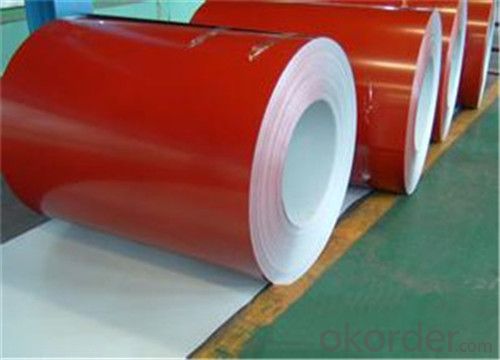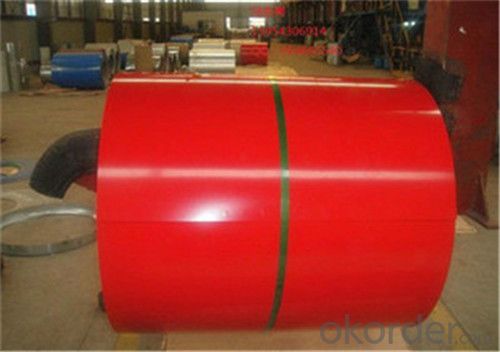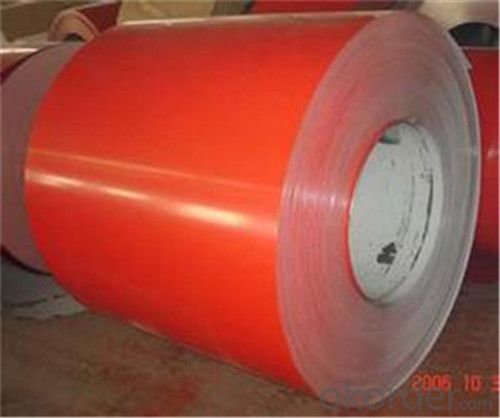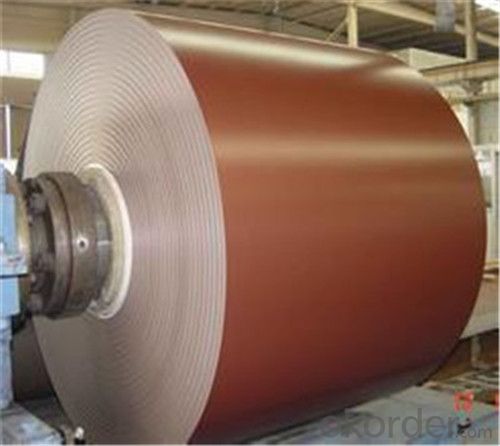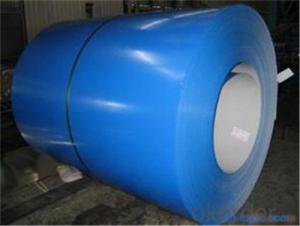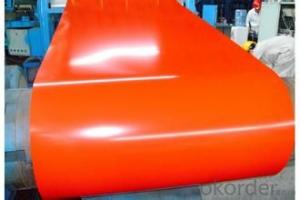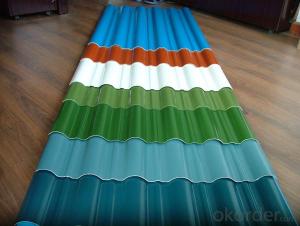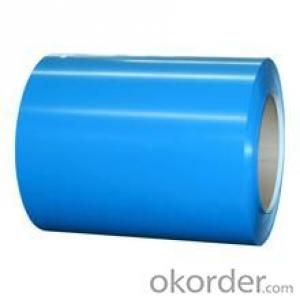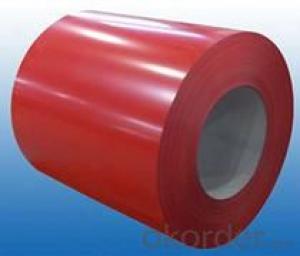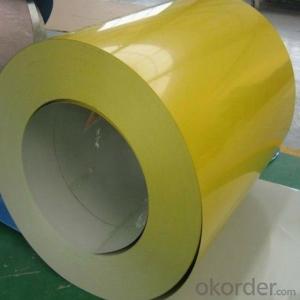Prepainted Galvanized Rolled Steel Sheet from CNBM
- Loading Port:
- Tianjin
- Payment Terms:
- TT OR LC
- Min Order Qty:
- 100 m.t.
- Supply Capability:
- 500000 m.t./month
OKorder Service Pledge
OKorder Financial Service
You Might Also Like
Description of Prepainted Galvanized Steel:
1.material : galvanized steel sheet / prepainted galvanized sheet
2.sheet thickness : normal use 0.3-0.6mm
3.length: any length, according to the transportation, generally less than 12m
4.color: standard color: red, blue, white, grey; special color: according to RAL color
Specification of Prepainted Galvanized Steel:
Thickness:0.15mm-1.2mm
Width:600mm-1250mm
Coil ID:508mm/610mm
Base Metal: GI/GL.
Zinc Coating:30-275 G/M2
Paint Coating: Top 30; Back 5-7. Or up to Buyer’s Option.
With Protection Film or Without Protection Film.
Spangle: Regular Spangle, Small Spangle, Zero Spangle.
Coil Weight:3-5MT or Customized Weight.
Delivery:15-25 days
MOQ:25MT
Color: RAL Color Series or Customized Colors.
Temper: Commercial Quality G 350; Structural Quality: G550; Full Hard.
Charactics of Prepainted Galvanized Steel
It can be widely used in transportation, light industry, civil usage and farming. It is also the perfect building material in construction for making steel roofing, insulation panel, corrugate sheet, facade wall, shutters, T-bar and home appliance.
Images of Prepainted Galvanized Steel:
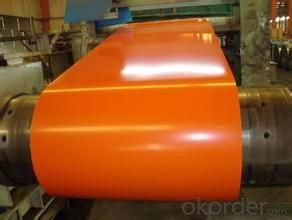
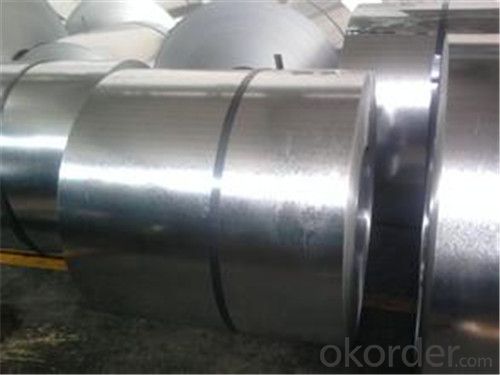
FAQ
1.What's your MOQ?
25MT, it is for one container.
2.Do you have QC teams?
Yeah, sure, our QC team is very important, they will keep the quality control for our products
- Q: What are the different coil packaging materials used for steel coils?
- There are several different coil packaging materials used for steel coils, each offering unique properties and benefits. Some of the most common materials include: 1. Stretch film: This is a popular choice for coil packaging due to its excellent flexibility and ability to tightly wrap around the coil. Stretch film provides good protection against dust, moisture, and scratches. 2. Steel strapping: Steel strapping is a robust and durable option for securing steel coils. It offers high tensile strength and resistance to breakage, ensuring the coils remain tightly bound during transport or storage. 3. Plastic strapping: Plastic strapping is a lightweight and cost-effective alternative to steel strapping. It offers good shock absorption and is resistant to rust and corrosion. Plastic strapping is often used for smaller or lighter steel coils. 4. Paperboard: Paperboard is a recyclable and eco-friendly packaging material. It provides a protective layer against dust and minor impacts, while also allowing slight breathability to prevent moisture buildup. 5. Wooden crates: Wooden crates are commonly used for large or heavy steel coils. They offer sturdy support and protection, preventing any damage during handling, transportation, or storage. 6. Corrugated cardboard: Corrugated cardboard is a versatile and lightweight packaging material suitable for smaller steel coils. It provides cushioning and protection against minor impacts, as well as being easily recyclable. The choice of coil packaging material depends on various factors such as the size and weight of the steel coils, transportation requirements, and desired level of protection. Each material has its own advantages and should be selected based on the specific needs of the steel coil packaging.
- Q: How are steel coils used in the manufacturing of transportation equipment?
- Steel coils are used in the manufacturing of transportation equipment as they provide a strong and durable material for various components such as frames, chassis, and body panels. The coils are shaped, cut, and formed into the desired shapes and sizes to create the structural integrity required for vehicles like cars, trucks, trains, and airplanes. The high strength of steel coils ensures the safety and stability of transportation equipment, making them essential in the manufacturing process.
- Q: If I wear a pair of thick wool socks, is walking around in the snow with steel-toed boots going to be a problem? I'm wondering if the steel will make my toes too cold.
- Dr. Martens makes a number of pairs of steel toed work boots. I have never owned a pair of their steel toes, but I have owned several pairs of their shoes and boots, the oldest of which is fifteen years old and still going strong. They take a couple of weeks to break in, but once they do, they are practically molded to your foot. They are more expensive, but they last a LONG time. Good Luck!
- Q: What are the factors that determine the price of steel coils?
- The price of steel coils is determined by various factors. 1. Raw material costs have a direct impact on steel coil prices. The prices of iron ore and coal, which are used in steel production, can fluctuate and affect the final price of steel coils. 2. Energy costs, such as electricity and fuel, play a significant role in determining the price of steel coils. Changes in energy costs, like oil or electricity price fluctuations, can influence the overall price. 3. The demand and supply dynamics in the steel industry are crucial in determining steel coil prices. When demand is high and supply is limited, prices tend to increase. Conversely, when demand is low and supply exceeds demand, prices tend to decrease. 4. Market conditions, including economic factors and trends, can impact steel coil prices. Economic growth, industrial production, and construction activities influence the demand for steel and therefore its price. 5. Production and labor costs, including labor wages, equipment, maintenance, and transportation, contribute to the final price of steel coils. Technological advancements and production efficiency can affect these costs and, subsequently, the price. 6. Trade policies and tariffs can also affect steel coil prices. Higher import tariffs can lead to increased domestic steel prices, while lower tariffs may result in lower prices due to increased import competition. 7. Currency exchange rates can impact steel prices as it is a globally traded commodity. If the currency in which steel is priced strengthens against other currencies, it can result in higher prices for steel coils. It is important to consider that these factors are interconnected and can vary based on market conditions, geographical location, and other external factors.
- Q: How are steel coils used in the marine industry?
- Steel coils are commonly used in the marine industry for various applications such as shipbuilding, offshore drilling platforms, and marine infrastructure. These coils are used to manufacture hull structures, decks, bulkheads, and other components, providing strength and durability needed to withstand harsh marine environments. Additionally, steel coils are also utilized in the production of marine equipment and machinery, ensuring the reliability and performance of marine vessels and structures.
- Q: Can steel coils be coated with aluminum?
- Yes, steel coils can be coated with aluminum through a process called coil coating.
- Q: what do you think about producebility of low density steel? for example: can density of 1020 steel (or ony others) be decreased without any loss of other properties.
- 1. A method has been developed for magnetic phase analysis of Fermanal type alloys as-quenched and after aging. 2. The upper limit of alloying to ensure the optimal mechanical properties was determined more precisely for steel 9G28Yu9MVB. For rods aged at 550°C for 16 h the aluminum content should not exceed 9.2% and the carbon content 0.92%. 3. To ensure the optimal mechanical properties of the deformed metal it is necessary to obtain a fine-grained single-phase austenitic structure after quenching. The amount of hardening phase after quenching should not exceed 15–20% (saturation magnetization around 1600 G).
- Q: How are steel coils used in automotive manufacturing?
- Steel coils are used in automotive manufacturing to create various components such as body panels, frames, and suspension parts. These coils are unwound, shaped, and cut into specific sizes and shapes to fit the required design. The steel's strength, durability, and flexibility make it an ideal material for ensuring the safety and structural integrity of vehicles.
- Q: Can steel coils be cut?
- Yes, steel coils can be cut using various methods such as shearing, sawing, or laser cutting, depending on the thickness and type of steel.
- Q: What are the common coil packaging methods?
- The common coil packaging methods include stretch wrapping, strapping, banding, and using coil covers.
Send your message to us
Prepainted Galvanized Rolled Steel Sheet from CNBM
- Loading Port:
- Tianjin
- Payment Terms:
- TT OR LC
- Min Order Qty:
- 100 m.t.
- Supply Capability:
- 500000 m.t./month
OKorder Service Pledge
OKorder Financial Service
Similar products
Hot products
Hot Searches
Related keywords
